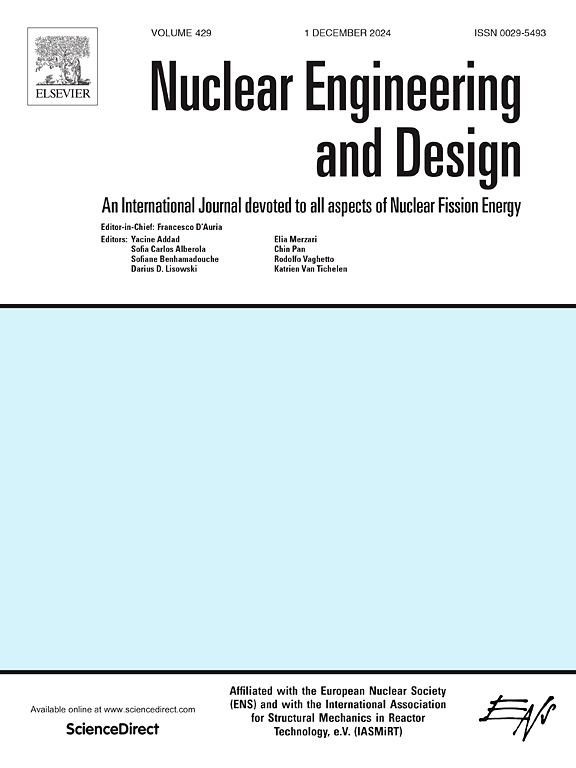基于MOOSE框架的热管冷却堆启动特性多物理场耦合仿真分析
IF 1.9
3区 工程技术
Q1 NUCLEAR SCIENCE & TECHNOLOGY
引用次数: 0
摘要
热管反应堆利用热管从堆芯传递裂变热,提供了高水平的被动安全性,因此代表了微反应堆的一个有前途的应用。热管反应堆的启动过程具有温度变化范围大、膨胀反应性反馈为主的特点,同时还需要考虑冷冻碱金属热管的启动问题,增加了很大的复杂性。为分析热管堆启动过程的特点,本研究将MOOSE框架与二维高温热管数值模拟代码KMC-HPs进行耦合,对核-热-机械动力学进行高精度多物理场耦合模拟研究,并通过地面原型堆KRUSTY的仿真验证了该耦合方法的准确性和可行性。分析表明,热管启动过程中的传热特性决定了堆芯内的温度分布。最初,热管的传热能力有限,导致温差很大。然而,随着温度的升高,热管蒸发段出现连续的蒸汽流动,传热能力提高,导致整个堆芯温度升高更加均匀,温差更小。力学分析表明,在热管和芯之间的接触面边缘存在较大的热应力,尽管这些应力远低于材料的屈服极限。本文从数值模拟的角度阐述了热管堆启动过程的多物理特性,开发的耦合框架为热管堆概念设计提供了高精度验证。本文章由计算机程序翻译,如有差异,请以英文原文为准。
Analysis of heat pipe cooled reactor startup characteristics by multi-physics coupling simulation based on MOOSE framework
A Heat pipe reactor utilizes heat pipes to transfer fission heat from the reactor core, providing a high level of passive safety and thus representing a promising application for micro-reactors. The startup process of a heat pipe reactor is characterized by a wide range of temperature variations and a dominant expansion reactivity feedback, while also necessitating consideration of the startup issues of the frozen alkali metal heat pipes, which adds significant complexity. To analyze the characteristics of the startup process of the heat pipe reactor, this study couples the MOOSE framework with the two-dimensional high-temperature heat pipe numerical simulation code KMC-HPs, to conduct a high-precision multi-physics coupling simulation study of the nuclear-thermal–mechanical dynamics, and the accuracy and feasibility of this coupling method were validated through simulations of the ground prototype reactor KRUSTY. The analysis indicates that the heat transfer characteristics during the startup process of the heat pipes determine the temperature distribution within the reactor core. Initially, the heat transfer capability of the heat pipes is limited, resulting in a significant temperature difference. However, as the temperature rises and continuous vapor flow occurs in the evaporation section of the heat pipes, the heat transfer capability improves, leading to a more uniform temperature increase across the core with a smaller temperature difference. Mechanical analysis reveals that large thermal stresses occur at the edges of the contact surfaces between the heat pipes and the core, although these stresses remain well below the material’s yield limits. This paper elucidates the multi-physical characteristics of the heat pipe reactor startup process from a numerical simulation perspective, and the developed coupling framework provides high-precision validation for the conceptual design of heat pipe reactors.
求助全文
通过发布文献求助,成功后即可免费获取论文全文。
去求助
来源期刊

Nuclear Engineering and Design
工程技术-核科学技术
CiteScore
3.40
自引率
11.80%
发文量
377
审稿时长
5 months
期刊介绍:
Nuclear Engineering and Design covers the wide range of disciplines involved in the engineering, design, safety and construction of nuclear fission reactors. The Editors welcome papers both on applied and innovative aspects and developments in nuclear science and technology.
Fundamentals of Reactor Design include:
• Thermal-Hydraulics and Core Physics
• Safety Analysis, Risk Assessment (PSA)
• Structural and Mechanical Engineering
• Materials Science
• Fuel Behavior and Design
• Structural Plant Design
• Engineering of Reactor Components
• Experiments
Aspects beyond fundamentals of Reactor Design covered:
• Accident Mitigation Measures
• Reactor Control Systems
• Licensing Issues
• Safeguard Engineering
• Economy of Plants
• Reprocessing / Waste Disposal
• Applications of Nuclear Energy
• Maintenance
• Decommissioning
Papers on new reactor ideas and developments (Generation IV reactors) such as inherently safe modular HTRs, High Performance LWRs/HWRs and LMFBs/GFR will be considered; Actinide Burners, Accelerator Driven Systems, Energy Amplifiers and other special designs of power and research reactors and their applications are also encouraged.
 求助内容:
求助内容: 应助结果提醒方式:
应助结果提醒方式:


